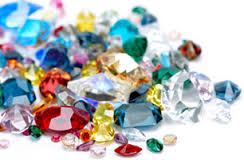Gemstone is a mineral or hard and petrified substance that can be polished and shaped for use in jewelry. A large variety of gemstones used in jewelry world, in generally there are several ways in which the stones can be classified and it is help to understand the difference. There include Natural vs. Genuine vs. Lab Created vs. Imitation.

Natural
Grown in the earth over millions of years under the right heat, temperature and chemicals to produce the stone. Mined underground or collected in deposits along rivers or oceans. They are not treated in any way to enhance color or clarity. The only “treatment” these stones have received is when they were cut in a certain shape.
Genuine
Genuine gemstones are natural stones that have undergone treatments to improve their look.
Lab-Created
The created gemstones are not considered fake since they are identical to natural ones in terms of structure despite being created by using different methods.
Lab-created gemstones are created through a process similar in composition to their naturally occurring mineral counterparts in which they do beneath the earth over millions of years, but they are grown in a controlled laboratory environment to yield a similar result. They are created under high pressure by using the same compounds that make up natural gemstones. This method reduces significantly time and the cost of mining.
Synthetic
The term “synthetic gemstone” is often used instead of “created gemstone”, “artificial”, “lab-grown”, “lab-made”, “man-made,” etc. Although these terms are used interchangeably, there are people who use the word “synthetic” to refer to fake gemstones. However, created gemstones are not considered fake since they are identical to natural ones in terms of structure despite being created by using different methods.
All these terms identify gemstones that are created in laboratories, not in nature. There are many processes for synthesizing gems. Some are inexpensive, some are very expensive, but they are all conducted artificially, in a lab. They may mimic or reproduce natural processes and use the same ingredients found in the natural stones. However, these processes are not occurring in nature. Fake gemstones, on the other hand, are simply imitations made of a different material.
Imitation/Simulant
Known as “simulants” that what people usually consider fake stones. These may look like a gemstone but are not the real thing. Because simulated stones are imitation and not made from the same minerals, they cost less and usually have no flaws, but they may not behave in the same way as their natural counterparts with respect to brilliance, sparkle, hardness or longevity. The imitated/simulated stones may be glass, plastic, cubic zirconia, or assembled stones. Any number of materials may be used to imitate or simulate a precious stone.
Note: Simulated and synthetic gemstones are two different things, and when shopping, you should be very careful not to buy a simulated stone advertised as synthetic.
At V-BELLO, you will find the following stones in jewelry selection:
Cubic Zirconia
Cubic zirconia (also called CZ) is a synthetic crystalline substance used as an affordable alternative to diamonds and gemstones. CZ is not a mineral, it is a man-made substance, not to be confused with the natural gemstone zircon. Though much less expensive than diamonds, the brilliance and crystal clarity of cubic zirconia make it one of today’s most popular stone choices for an attractive, inexpensive, and diamond-like jewelry. Most cubic zirconia is bright white to mimic diamond. However, cubic zirconia is also enhanced with other minerals and manufactured in most any color.
Zircon
Zircon is a colorful natural gem with high refraction and fire that’s unfairly confused with cubic zirconia. That makes it a desirable gem.
Rhinestone
known as crystal glass. It is a diamond simulant originally made from rock crystal but since the 19th century from crystal glass or polymers such as acrylic. It also made from naturally occurring quartz crystals.
What difference between Cubic zirconia(CZ) and Rhinestone? The biggest difference between rhinestones and cubic zirconia is in how they are made. The first rhinestones were quartz crystals gathered from the Rhine River in Germany, so their name came from. The highest quality rhinestones are still made from cut quartz crystals, though more inexpensive rhinestones can be made from glass, acrylic, or paste. On the other hand, cubic zirconia is synthetically made of zirconium oxide to simulate the appearance of a diamond.
Agate
Agate is a semi-precious gemstone. It is formed in multi-colored concentric layers. No two agates are quite the same. Agate is classified as a banded chalcedony or micro-crystalline quartz. The individual bands or layers give this gemstone its uniqueness and characters.
